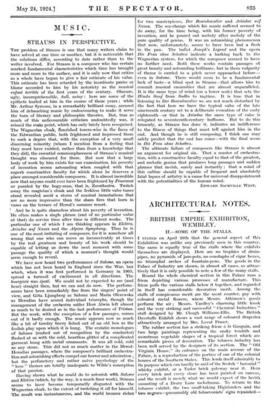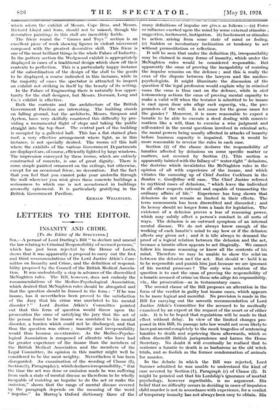ARCHITECTURAL NOTES.
'BRITISH EMPIRE EXHIBITION/ WEMBLEY.
11.—SOME OF THE STALLS.
I STATED on April 26th that the general aspect of this Exhibition was unlike any previously seen in this country. The same is equally true of the stalls where the exhibits themselves are displayed. Here are no trophies of drain- pipes, no pyramids of jam-pots, no cenotaphs of cigar boxes, no triumphal arches of fountain-pens. The goods in the Palace of Industry are shown, in almost all cases, so attrac- tively that it is only possible to note a few of the many stalls. ■
Round the whole chemical section in this Palace runs a frieze depicting various processes of manufacture. This frieze pulls the various stalls below it together, and regarded in itself has considerable decorative merit. Among the stalls of conspicuous merit are the scent counter, gay with coloured metal flowers, where Messrs. Atkinson's goods perfume the air ; Messrs. Yardley's charming little kiosk and the very striking and successful "Chemical Industries" stall designed by Mr. Clough Williams-Ellis. The British Dyestuffs Exhibit shows a vast range of coloured draperies attractively arranged by Mrs. Lovat Fraser. The rubber section has a striking frieze a la Gauguin, and two large paintings representing the snaky tendrils and monstrous vegetable shapes of a tropical forest which are remarkable pieces of decoration. The tobacco industry has been well served by the designers of its section. The "Old Virginia House," its entrance on the main avenue of the Palace, is a reproduction of the portico of one of the colonial houses of the Southern States. This lends itself admirably to its purpose which can hardly be said of the Scotch" baronial" whisky exhibit, or a Tudor brick gateway near it. Here every brick and every stone has been painted on canvas, and the result is merely what we would expect of the lavish mounting of a Drury Lane melodrama. To return to the tobacco exhibit, the two snuff-taking Highlanders and the two negroes—presumably old tobacconists' signs repainted- which adorn the exhibit of Messrs. Cope Bros. and Messrs. Richard Lloyd and Sons, should not be missed, though the decorative paintings in this stall are incredibly feeble.
The frieze round the "Games and Toys " section is an excellent piece of work showing figures in violent movement composed with the greatest decorative skill. This frieze is one of the most brilliant things in the whole Palace of Industry. In the pottery section the Wedgwood exhibit is appropriately displayed in cases of a traditional design which show off their contents to perfection. This is a particularly happy instance of the subordination of the design of the stall to the goods to be displayed, a course indicated in this instance, while in the majority of cases the spectator is attracted to inspect an exhibit not striking in itself by the beauty of its setting.
In the Palace of Engineering there is naturally less oppor- tunity for the stall designer, but Messrs. Dormaxr, Long and Co.'s exhibit is effective.
Both the contents and the architecture of the British Government Pavilion are interesting. The building stands on falling ground, but the architects, Messrs. Simpson and Ayrton, have very skilfully countered this difficulty by pro- viding a monumental flight of steps and taking the public straight into the top floor. The central part of the building is occupied by a galleried hall. This has a flat stained glass roof, a very effective arrangement where light, as in this instance, is not specially desired. The rooms off this hall where the exhibits of the various Government Departments are displayed are, of course, efficiently lighted by large windows. The impression conveyed by these rooms, which are entirely constructed of concrete, is one of great dignity. There is some simple painted ornament on the ceilings, but otherwise, except for an occasional frieze, no decoration. But the fact that you feel that you cannot poke your umbrella through the wall wherever you wish gives these concrete buildings a seriousness to which one is not accustomed in buildings avowedly ephemeral. It is particularly gratifying in the British Government Pavilion.
GERALD WELLESLEY.











































 Previous page
Previous page